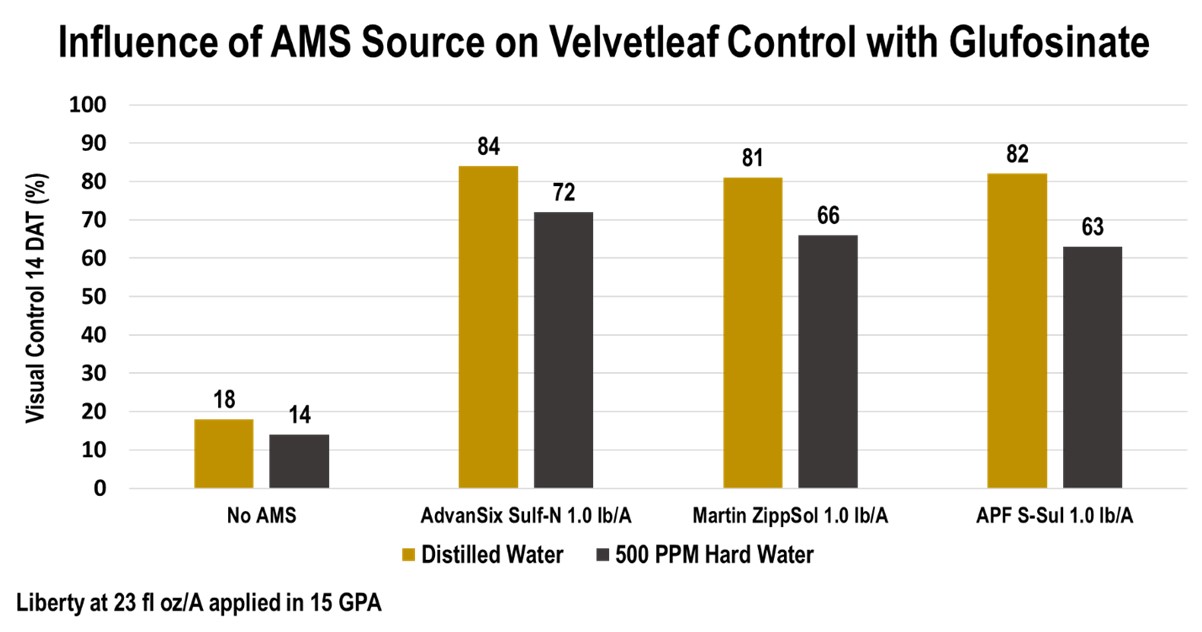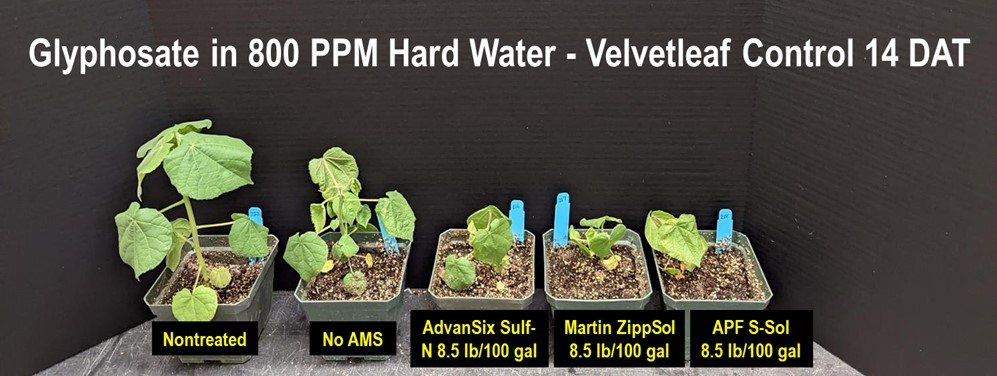During this time of year, many growers are making decisions about purchasing inputs for the next growing season. It is very common to lock in fertilizer prices during the fall, and with the utility of AMS as both a fertilizer and a spray adjuvant, we routinely get questions about some of the different AMS products that are carried by ag retailers.
There are a number of different sources of AMS products that can be used with weak acid herbicides to overcome hard water antagonism and improve efficacy. Some of these products contain ingredients that impart a slight difference in color of the AMS product. Some companies will use this as a marketing ploy to indicate that it implies it is a lower quality product.
We conducted a greenhouse trial to compare one of the off-colored AMS products (AdvanSix AMS) with commonly used white AMS products (Martin ZippSol and APF S-Sul). We planted barnyardgrass and velvetleaf in greenhouse pots, allowed the weeds to grow to around 6 inches in height, and applied herbicide treatments with a greenhouse track sprayer. The reason we use barnyardgrass and velvetleaf in adjuvant trials, is that these weeds are somewhat difficult to control with both glyphosate and glufosinate, and we have learned that these weed species provide reliable responses to adjuvants in the hundreds of adjuvant trials that we have done over the last several years. In this trial we evaluated control of both barnyardgrass and velvetleaf with glyphosate (Roundup PowerMax), velvetleaf control with glufosinate (Liberty).
The rates of herbicides used were Roundup PowerMax at 16 fluid ounces per acre for barnyardgrass, 21 fluid ounces per acre for velvetleaf, and Liberty at 23 fluid ounces per acre for velvetleaf. In our adjuvant trials, we choose a herbicide rate that will provide somewhat marginal control so we can tease out the impact of any adjuvant that would be added to the spray solution. We evaluated three different AMS products. The AdvanSix product is an off-color AMS product, while the Martin and APF products are classified as “white” AMS products. In order to test the impact of the AMS products on overcoming antagonism by hard water, the spray solutions were made-up in one of three different hardness levels. The hardness levels we evaluated were zero, 500, and 800 parts per million.
In Figure 1, we show the weed control with glyphosate in hard water, (800 parts per million), that is well above the average hardness that we see in the eastern corn belt, which ranges from about 100 to 350 parts per million. The data in figure 1 show that velvetleaf and barnyardgrass control without AMS is around 60%. The addition of any source of AMS increases control around 10% and there were no significant differences between any of the AMS brands.
In figure 2, we show velvetleaf control with Liberty, and compare the control in distilled water versus 500 parts per million of hardness with the three AMS products. In the absence of AMS, velvetleaf control is less than 20%. The addition of AMS, whether it be to distilled water or hard water increases control 50% or more and there are no significant differences between the three AMS products.
In figure 3, we show velvetleaf control with glufosinate, and compare 1 lb/A per acre to 2 lb/A per acre of three ammonium sulfate products. Once again we see no significant difference between the ammonium sulfate products, and note that the addition of ammonium sulfate increases control of velvetleaf at least 50%, and that there this is an advantage to increasing the rate of AMS to 2 lb/A when the spray solution contains 500 ppm of hardness.
While we recognize the importance of showing data in a graphic format it’s also important to view pictures of the results as well. Shown below are a couple of pictures of the treated plants at 14 days after treatment with various levels of hardness, and the three ammonium sulfate products. The headings on these photographs should be self-explanatory to describe what is shown in the pictures.
In conclusion, the results of this greenhouse experiment indicate that there are really no differences in the control of barnyardgrass and velvetleaf with glyphosate, or velvetleaf control with glufosinate with these three sources of AMS. The off color AMS product worked just as well as the white color AMS product in these trials.











